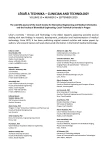A MATLAB-BASED GUI FOR REMOTE
ELECTROOCULOGRAPHY VISUAL EXAMINATION
Autoři:
Tomas Stula 1; Antonino Proto 2; Jan Kubicek 2; Lukas Peter 2; Martin Cerny 2; Marek Penhaker 2
Působiště autorů:
Laboratory of testing and measurement, Physical-Technical Testing Institute, Ostrava, Czech Republic
1; Department of Cybernetics and Biomedical Engineering, VSB-TUO, Ostrava, Czech Republic
2
Vyšlo v časopise:
Lékař a technika - Clinician and Technology No. 3, 2020, 50, 101-113
Kategorie:
Original research
doi:
https://doi.org/10.14311/CTJ.2020.3.04
Souhrn
In this work, a MATLAB-based graphical user interface is proposed for the visual examination of several eye movements. The proposed solution is algorithm-based, which localizes the area of the eye movement, removes artifacts, and calculates the view trajectory in terms of direction and orb deviation. To compute the algorithm, a five-electrode configuration is needed. The goodness of the proposed MATLAB-based graphical user interface has been validated, at the Clinic of Child Neurology of University Hospital of Ostrava, through the EEG Wave Program, which was considered as “gold standard” test. The proposed solution can help physicians on studying cerebral diseases, or to be used for the development of human-machine interfaces useful for the improvement of the digital era that surrounds us today.
Zdroje
- Du Bois-Reymond E. Untersuchungen über thierische Elektri-cität. Berlin: Reimer, 1848.
- Leigh RJ, Zee DS. The neurology of eye movements. 5th ed. Oxford University Press. 2015. ISBN: 9780199969289.
- Rayner K. Eye movements in reading and information processing: 20 years of research. Psychological Bulletin. 1998; 124(3):372–422. DOI: 10.1037/0033-2909.124.3.372
- Peter L, Janoscova B, Proto A, Cerny M. Electrooculography as a tool for managing application. In: IEEE International Conference on E-health Networking, Application & Services. Ostrava: IEEE Communications Society. 2018;1–5. DOI: 10.1109/HealthCom.2018.8531178
- Majaranta PA, Bulling A. Eye Tracking and Eye-Based Human–Computer Interaction. In: Fairclough, S.; Gilleade, K. Advances in Physiological Computing. Human–Computer Interaction Series. Springer, UK. 2014.
DOI: 10.1007/978-1-4471-6392-3_3 - Singh H, Singh J. Human Eye Tracking and Related Issues: A Review. International Journal of Scienific and Research Publications. 2012;2(9):1–9. ISSN 2250-3153.
- Fejtova M, Fejt J, Lhotska L. Controlling a PC by eye move-ments: the MEMREC project. In: Proceedings of the Computers Helping People with Special Needs: 9th International Conference. Paris: Springer. 2004.
DOI: 10.1007/978-3-540-27817-7_114 - Chen MC, Yu H, Huang ZL, Lu J. Rapid eye movement sleep behavior disorder. Current Opinion in Neurobiology. 2013;23(5):793–8. DOI: 10.1016/j.conb.2013.02.019
- Barnes D, McDonald WI. The ocular manifestations of multiple sclerosis. 2. Abnormalities of eye movements. Journal of Neurology, Neurosurgery, and Psychiatry. 1992;55(10):863–8. DOI: 10.1136/jnnp.55.10.863
- Nair G, Kim M, Nagaoka T, Olson DE, Thule PM, Pardue MT, Duong TQ. Effects of common anesthetics on eye movement and electroretinogram. Documenta Ophthalmologica. 2011; 122(3):163–76. DOI: 10.1007/s10633-011-9271-4
- Eggert T. Eye movement recordings: Methods. Developments in Ophthalmology. 2007;40:15–34, DOI: 10.1159/000100347
- Martinez-Cervero J, Ardali MK, Jaramillo-Gonzalez A, Wu S, Tonin A, Birbaumer N, Chaudhary U. Open Software/Hard-ware Platform for Human-Computer Interface Based on Electrooculography (EOG) Signal Classification. Sensors. 2020 May;20(9). DOI: 10.3390/s20092443
- Jaramillo-Gonzalez A, Wu S, Tonin A, Rana A, Ardali MK, Birbaumer N, Chaudhary U. A dataset of EEG and EOG from an auditory EOG-based communication system for patients in locked-in state. Scientific Data. 2021;8(1). DOI: 10.1038/s41597-020-00789-4
- Milanizadeh S, Safaie J. EOG-Based HCI System for Quad-copter Navigation. IEEE Transactions on Instrumentation and Measurement. 2020; 69(11):8992–9. DOI: 10.1109/TIM.2020.3001411
- Barbara N, Camilleri TA, Camilleri KP. A comparison of EOG baseline drift mitigation techniques. Biomedical Signal Processing and Control. 2020;57. DOI: 10.1016/j.bspc.2019.101738
- Thakor NV. Biopotentials and Electrophysiology Measure-ment. In: Webster, J.G. The Measurement, Instrumentation, and Sensors Handbook. vol. 74. CRC Press LLC, USA, 1999.
- Lopez A, Ferrero F, Valledor M, Campo JC, Postolache O. A study on electrode placement in EOG systems for medical applications. In: Proceedings of the IEEE International Sympo-sium on Medical Measurements and Applications. Benevento. 2016. DOI: 10.1109/MeMeA.2016.7533703
- Aminoff M J. Aminoff’s Electrodiagnosis in Clinical Neurolo-gy, 6th Ed.; Elsevier, 2012. ISBN: 9781455726769.
- Daly DD, Pedley TA. Current Practice of Clinical Electro-encephalography, 2nd Ed.; Publisher: Raven Press, USA, 1990.
- Berg P, Scherg M. Dipole models of eye movements and blinks. Electroencephalography and Clinical Neurophysiology. 1991; 79(1):36–44. DOI: 10.1016/0013-4694(91)90154-V
- Ifeachor EC, Jervis BW, Allen EM, Morris EL, Wright DE, Hudson NR. Investigation and comparison of some models for removing ocular artefacts from EEG signals. Part 2 Quantitative and pictorial comparison of models. Medical and Biological Engineering and Computing. 1988;26(6):591–8. DOI: 10.1007/BF02447496
- Gasser T, Sroka L, Mocks J. The Correction of EOG Artifacts by Frequency Dependent and Frequency Independent Methods. Psychophysiology. 1986;23(6):704–12.
DOI: 10.1111/j.1469-8986.1986.tb00697.x - Kohonen T. Self-organising maps. Berlin: Springer, 1995. ISBN 3-540-58600-8.
- Ileri R, Latifoglu F, Demirci E. New Method to Diagnosis of Dyslexia Using 1D-CNN. In: Proceedings of the Medical Technologies Congress, TIPTEKNO. Antalya. 2020. DOI: 10.1109/TIPTEKNO50054.2020.9299241
- Liebich S, Bruser C, Leonhardt S. Deconvolution-based physio-logical signal simplfication for periodical parameter estimation. Lékař a technika-Clinician and Technology. 2014; 44(2):18–24.
- Conforto S, D’Alessio T. Spectral analysis for non-stationary signals from mechanical measurements: a parametric approach. Mechanical Systems and Signal Processing. 1999;13(3):395–411. DOI: 10.1006/mssp.1998.1220
- Penhaker M, Stula T, Cerny M. Automatic Ranking of Eye Movement in Electrooculographic Records. In: Proceedings of the 2nd IEEE International Conference on Computer Engineer-ing and Applications. Bali Island, 2010. DOI: 10.1109/ICCEA.2010.238
- EEG Wave Program. Accessed: Feb. 08, 2021. [Online]. Available: https://deymed.cz/truscan-eeg
Štítky
BiomedicínaČlánek vyšel v časopise
Lékař a technika

2020 Číslo 3
Nejčtenější v tomto čísle
- OPTIMIZED CONVECTIVE VOLUME IN ONLINE HEMODIAFILTRATION
- HEALTH FAILURE MODE AND EFFECTS ANALYSIS APPLIED TO HOME MECHANICAL VENTILATION
- PROTECTIVE ASPECTS IN CONTACTLESS INFRARED THERMOGRAPHY FEVER SCREENING
-
XANTHENE DYES-MEDIATED IN VITRO PHOTODYNAMIC
TREATMENT OF CANCER AND NON-CANCER CELL LINES
